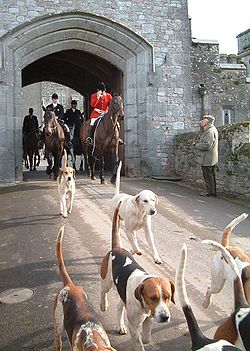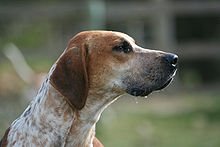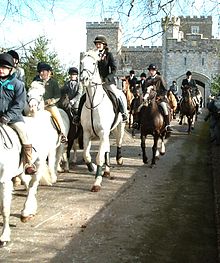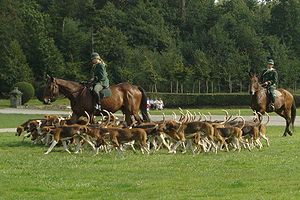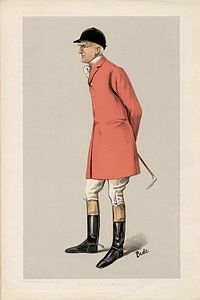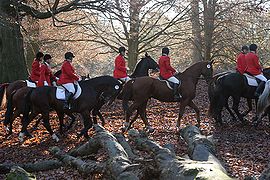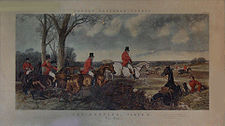- Fox hunting
-
For other uses, see Fox hunting (disambiguation).Master of foxhounds leads the field from Powderham Castle in Devon, England, with the hounds in front.

Fox hunting is an activity involving the tracking, chase, and sometimes killing of a fox, traditionally a red fox, by trained foxhounds or other scent hounds, and a group of followers led by a master of foxhounds, who follow the hounds on foot or on horseback.[1]
Fox hunting originated in its current form in the United Kingdom in the 16th century, but is practised all over the world, including in Australia, Canada, France, Ireland, Italy, Russia, and the United States.[2][3] In Australia, the term also refers to the hunting of foxes with firearms similar to spotlighting or deer hunting.
The sport is controversial, particularly in the UK, where bans were introduced for Scotland in 2002, then for England and Wales in November 2004 (law enforced from February 2005).[4] Proponents see it as an important part of rural culture and useful for reasons of conservation and pest control,[5][6][7] while opponents argue that it is cruel and unnecessary.[8]
Contents
History
Main article: Hunting — HistoryThe use of scenthounds to track prey dates back to Assyrian, Babylonian, and ancient Egyptian times, and was known as venery.[9]
Europe
Many Greek- and Roman- influenced countries have long traditions of hunting with hounds. Hunting with Agassaei hounds was popular in Celtic Britain, even before the Romans arrived, introducing the Castorian and Fulpine hound breeds which they used to hunt.[3] Norman hunting traditions were brought to Britain when William the Conqueror arrived, along with the Gascon and Talbot hounds.
Foxes were referred to as beasts of the chase by medieval times, along with the red deer (hart & hind), martens, and roes,[10] but the earliest known attempt to hunt a fox with hounds was in Norfolk, England, in 1534, where farmers began chasing foxes down with their dogs for the purpose of pest control .[3] The first use of packs specifically trained to hunt foxes was in the late 1600s, with the oldest fox hunt being, probably, the Bilsdale in Yorkshire.[11] By the end of the seventeenth century, deer hunting was in decline. The Inclosure Acts brought fences to separate open land into fields, deer forests were being cut down, and arable land was increasing.[12] With the onset of the Industrial Revolution, people began to move out of the country and into towns and cities to find work. Roads, rail, and canals split hunting countries,[13] but also made hunting accessible to more people. Shotguns were improved during the nineteenth century and the shooting of gamebirds became more popular.[12] Fox hunting developed further in the eighteenth century when Hugo Meynell developed breeds of hound and horse to address the new geography of rural England.[12]
To protect pheasants for shooters, gamekeepers culled foxes almost to extinction in many areas, which caused the huntsmen to improve their coverts to preserve their quarry.[12] The Game Laws were relaxed in 1831, which meant that anyone could obtain a permit to take rabbits, hares, and game birds.[14]
In Germany, hunting with hounds was first banned on the initiative of Hermann Göring on July 3, 1934. [15] In 1939, the ban was extended to cover Austria after Germany's annexation of the country. Bernd Ergert, the director of Germany's hunting museum in Munich, said of the ban, "The aristocrats were understandably furious, but they could do nothing about the ban given the totalitarian nature of the regime."[15]
United States
 The Fox Hunt, Alexandre-François Desportes
The Fox Hunt, Alexandre-François Desportes
According to the Masters of Foxhounds Association of America, Englishman Robert Brooke was the first man to import hunting hounds to America, bringing his pack to Maryland in 1650 when he imported his horses and a pack of foxhounds.[16] Also around this time, numbers of European red foxes were introduced into the Eastern seaboard of North America for hunting.[17][18] The first organised hunt for the benefit of a group (rather than a single patron) was started by Thomas, sixth Lord Fairfax in 1747.[16] In the United States, George Washington and Thomas Jefferson both kept packs of fox hounds before and after the American Revolutionary War.[19][20]
Australia
In Australia, the European red fox was introduced solely for the purpose of fox hunting in 1855.[21] Native animal populations have been very badly affected, with the extinction of at least 10 species attributed to the spread of foxes.[21] Fox hunting continues in Australia, with thirteen clubs with over 1000 members, still hunting with horses and hounds, in the state of Victoria.[22] Fox hunting with hounds results in around 650 foxes being killed annually in Victoria,[22] compared with over 90,000 shot over a similar period in response to a State government bounty.[23]
Current status
See also: Fox hunting legislation and List of fox hunts in the United KingdomUnited Kingdom
The controversy around fox hunting led to the passing of the Hunting Act 2004 in November of that year, after a free vote in the House of Commons, which made hunting with dogs unlawful in England and Wales from February 18, 2005.[24] An amendment which allowed licensed hunting under stricter conditions, advocated by the then Prime Minister Tony Blair[4] and some members of the government's independent inquiry on fox hunting (including its chairman Lord Burns[25]), was voted down.[26] The passing of the Hunting Act was also notable in that it was implemented through the use of the Parliament Acts 1911 and 1949 after the House of Lords refused to pass the legislation, despite the Commons passing it by a majority of 356 to 166.[4][27] Scotland, which has its own Parliament, banned fox hunting in 2002, over two years before the ban in England and Wales.[28] Fox hunting remains legal in Northern Ireland.[29][30]
After the ban on fox hunting, hunts say that they follow artificially laid trails, although the League Against Cruel Sports has alleged widespread law breaking.[31] Supporters of fox hunting claim that the number of foxes killed by dogs has increased since the ban, that hunts have reported an increase in membership [32] and that around 320,000 people (their highest recorded number) turned up to fox hunts on Boxing Day 2006.[33] The Master of Foxhounds association lists 184 active hunts as of November 2008.
United States
In America, fox hunting is also called 'fox chasing,' as the purpose is not to actually kill the animal but to enjoy the thrill of the chase.[16] A hunt may go without a kill for several years, despite chasing two or more foxes in a single day's hunting.[34] As a rule, foxes are not pursued once they have 'gone to ground.' American fox hunters undertake stewardship of the land, and endeavour to maintain fox populations and habitats as much as possible.[34]
In 2007, the Masters of Foxhounds Association of North America listed 171 registered packs in the U.S. and Canada.[35] This number does not include the nonregistered (also known as 'farmer' or 'outlaw') packs.[34] In some arid parts of the Western United States, where foxes in general are more difficult to locate, hunts track coyotes[36] and, in some cases, bobcats.[37]
Other countries
Fox hunting with hounds is practised in countries including Australia, Canada, France, India, Ireland, Italy,[38] and Russia[2][3] whereas the Burns Inquiry reported that fox hunting was "not practised or is largely banned" in Spain, Belgium, Germany, Sweden, Denmark, Finland and Norway.[1]
Animals
Quarry animals
Red fox
 The red fox is the main prey of European and American fox hunts.
The red fox is the main prey of European and American fox hunts.
The red fox (Vulpes vulpes) is the normal prey animal of a fox hunt in the U.S. and Europe. A small omnivorous predator,[39] the fox lives in underground burrows called earths,[40] and is predominantly active around twilight (making it a crepuscular animal).[41] Adult foxes tend to range around an area of between 5 and 15 square kilometers (2–6 square miles) in good terrain, although in poor terrain, their range can be as much as 20 square kilometres (7.7 sq mi).[41] The red fox can run at up to 48 km/h (30 mph).[41] The fox is also variously known as a Tod (old English word for fox),[42] Reynard (the name of an anthropomorphic character in European literature from the twelfth century),[43] or Charlie (named for the Whig politician Charles James Fox).[44] American red foxes tend to be larger than European forms, but according to hunter's accounts, they have lesser cunning, vigour and endurance in the chase compared to the European foxes.[45]
Coyote, gray fox, and other quarry
Further information: Jackal coursing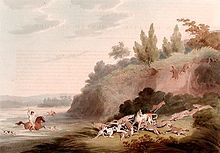 Hunting Jackals by Samuel Howitt, illustrating a group of golden jackals rushing to the defence of a fallen pack-mate
Hunting Jackals by Samuel Howitt, illustrating a group of golden jackals rushing to the defence of a fallen pack-mate
Other species than the red fox may be the quarry in a Hunt. The choice of quarry depends on the region and numbers available.[16] The coyote (Canis latrans) is a significant quarry for many Hunts in North America, particularly in the west and southwest, where there are large open spaces.[16] The coyote is an indigenous predator that did not range east of the Mississippi River until the latter half of the 20th century.[46] The coyote is faster than a fox, running at 65 km/h (40 mph) and also wider ranging, with a territory of up to 283 square kilometres (109 sq mi),[47] so a much larger hunt territory is required to chase it. However, coyotes tend to be less challenging intellectually, as they offer a straight line hunt instead of the convoluted fox line. Coyotes can be challenging opponents for the dogs in physical confrontations, despite the size advantage of a large dog. Coyotes have larger canine teeth and are generally more practised in hostile encounters.[48]
The gray fox (Urocyon cinereoargenteus), a distant relative of the European red fox, is also hunted in North America.[16] It is an adept climber of trees, making it harder to hunt with hounds.[49] The smell of the grey fox is not as strong as that of the red, therefore more time is needed for the hounds to take the scent. Unlike the red fox which, during the chase, will run far ahead from the pack, the grey fox will speed toward heavy brush, thus making it more difficult to pursue. Also unlike the red fox, which occurs more prominently in the northern United States, the more southern grey fox is rarely hunted on horseback, due to its densely covered habitat preferences. Generally, two hours are required to fully tire out and capture a grey fox with hounds.[50]
Hunts in the southern United States sometimes pursue the bobcat (Lynx rufus).[16] In countries such as India, and in other areas formerly under British influence, such as Iraq, the golden jackal (Canis aureus) is often hunted.[51][52] During the British Raj, British sportsmen in India would hunt jackals on horseback with hounds as a substitute for the fox hunting of their native England. Unlike foxes, golden jackals were documented to be ferociously protective of their pack mates, and could seriously injure dogs.[53][54] Jackals were not hunted often in this manner, as they were slower than foxes and could scarcely outrun greyhounds after 200 yards.[55]
Animals of the hunt
Hounds and other dogs
Fox hunting is usually undertaken with a pack of scent hounds,[1] and, in most cases, these are specially bred foxhounds.[56] These dogs are trained to pursue the fox based on its scent. The two main types of foxhound are the English Foxhound[57] and the American Foxhound.[58] It is possible to use a sight hound such as a Greyhound or lurcher to pursue foxes,[59] though this practice is not common in organised hunting, and these dogs are more often used for coursing animals such as hares.[60] There is also one pack of beagles in Virginia that hunt fox. They are unique in that they are the only hunting beagle pack in the U.S. to be followed on horseback. English Foxhounds are also used for hunting mink.
Hunts may also use terriers to flush or kill foxes that are hiding underground,[1] as they are small enough to pursue the fox through narrow earth passages.
Horses
Main article: Field hunterThe horses, called "field hunters" or hunters, ridden by followers of the hunt, are a prominent feature of many hunts, although others are conducted on foot (and those hunts with a field of horseback-mounted riders may also have foot followers). Horses on hunts can range from specially bred and trained field hunters to casual hunt attendees riding a wide variety of horse and pony types. Draft and Thoroughbred crosses are commonly used as hunters, although purebred Thoroughbreds and horses of many different breeds are also used. Some hunts with unique territories favor certain traits in field hunters, for example, when hunting coyote in the western U.S., a faster horse with more stamina is required to keep up, as coyotes are faster than foxes and inhabit larger territories. Hunters must be well-mannered, have the athletic ability to clear large obstacles such as wide ditches, tall fences, and rock walls, and have the stamina to keep up with the hounds.[61]
Dependent on terrain, and to accommodate different levels of ability, hunts generally have alternative routes that do not involve jumping. The hunt may be divided into two groups, with one group, the First Field, that takes a more direct but demanding route that involves jumps over obstacles[62] while another group, the Second Field (also called Hilltoppers or Gaters), takes longer but less challenging routes that utilize gates or other types of access on the flat.[62][63]
Birds of prey
In the United Kingdom, since the introduction of the hunting ban, a number of hunts have employed falconers to bring birds of prey to the hunt, due to the exemption in the Hunting Act for falconry.[64] The legality of this will be tested by a private prosecution being brought by the League Against Cruel Sports.[65]
Procedure
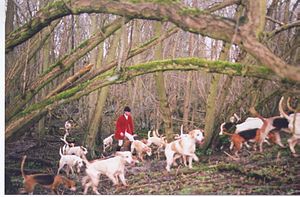 The Bedale Hunt, Yorkshire, drawing a wood in February 2005
The Bedale Hunt, Yorkshire, drawing a wood in February 2005
Fox hunts are the setting for many social rituals, but the hunting itself begins when hounds are "cast" or put into rough or brushy areas called "coverts", where foxes often lay up during daylight hours or when they hear dogs moving toward them. If the pack manages to pick up the scent of a fox, they will track it for as long as they are able. Scenting can be affected by temperature, humidity, and other factors. The hounds pursue the trail of the fox and the riders follow, by the most direct route possible. Since this may involve very athletic skill on the part of horse and rider alike, fox hunting is the origin of traditional equestrian sports including steeplechase[66] and point to point racing.[67] The hunt continues until either the fox evades the hounds, goes to ground (that is takes refuge in an underground burrow or den) or is overtaken and usually killed by the hounds. In the case of Scottish hill packs or the gun packs of Wales and upland areas of England, the fox is flushed to guns. Hunts in the Cumbrian fells and other upland areas are followed by supporters on foot rather than on horseback. In the UK, where the fox goes to ground, terriers may be entered into the earth to locate the fox so that it can be dug down to and killed.[1]
Social rituals are important to hunts, although many have fallen into disuse. One of the most notable was the act of blooding. This is a very old ceremony in which the master or huntsman would smear the blood of the fox or coyote onto the cheeks or forehead of a newly initiated hunt follower, often a young child.[68] Another practice of some hunts was to cut off the tail ('brush'), the feet ('pads') and the head ('mask') as trophies, with the carcass then thrown to the dogs.[68] Both of these practices were widely abandoned during the nineteenth century, although isolated cases may still have occurred to the modern day.[68]
Autumn or cub hunting
In the autumn of each year (August–October in the UK), hunts take the young hounds out cub hunting or autumn hunting in order to cull weaker young foxes (which are full size by autumn season as they are born in spring,[13] albeit not yet sexually mature until they are 10 months old and still living in their family group[41]) and teach the young fox hounds to restrict their hunting to foxes.[1][69] In Britain, the activity consists of hunt supporters surrounding a covert, with riders and foot followers to drive back foxes attempting to escape, and then 'drawing' the covert with the puppies and some more experienced hounds, allowing them to find, attack and kill the young foxes within the surrounded wood.[1] A young hound is considered to be 'entered' into the pack once he or she has successfully joined in a hunt in this fashion. Only rarely, in about 1 in 50 cases, foxhounds do not show suitable aptitude, and must be removed from the pack.[70]
In the U.S., some cubs are chased and allowed to escape to teach them better skills of evasion so that they may be tracked (preferably without being killed) again another day.[citation needed] Many foxes learn to evade the hounds by running up or down streams, running along the tops of fences, and other tactics to throw the hounds off the scent.[71]
Main hunting season
Once the season proper starts (usually from early November in the northern hemisphere,[13] or May in the southern hemisphere), the idea is to drive the fox from the covert and chase it for long distances over open countryside. The northern hemisphere season continues through to April, though a few hunts continue into early May.
Drag, trail and bloodhound hunting
Drag hunting, an equestrian sport which involves dragging an object over the ground to lay a scent for the hounds to follow,[72] can also be popular, either instead of, or in addition to, live quarry hunting. Drag hunts are often considered to be faster than standard fox hunts, with followers not having to wait while the hounds pick up a trail, and often covering an area far larger than a traditional hunt,[73] which may even necessitate a change of horses half way through.[74] A non-equestrian variation, hound trailing, is practiced in the Lake District.[75] Since the UK hunting ban, hunts claim to use a mixture of an odoriferous substance with an oil in order to improve the persistence of the scent trail, and then to lay the scent about 20 minutes in advance of the hunt.[76] Bloodhounds are also used to hunt a human runner in the sport of Hunting the Clean Boot.[73][77]
Shooting foxes
In Australia, fox hunting also involves hunting foxes with firearms, much the same as deer or rabbit, although Australia also has mounted hunts with hounds. Introduced red foxes are regarded as a serious problem for farmers in Australia, having been introduced by huntsmen in the nineteenth and twentieth century for sporting purposes;[78] as such, their expedient removal is viewed by farmers as the priority, rather than the traditional fox hunt in the UK. Alongside methods such as trapping and poisoning, hunters usually work at night with a spotlight and a small to medium calibre rifle,[79] known as "spotlighting", or "lamping" in the UK and Ireland.[80]
People
Hunt staff and officials
As a social ritual, participants in a fox hunt fill specific roles, the most prominent of which is the master, often more than one and then called masters or joint masters. These individuals typically take much of the financial responsibility for the overall management of the sporting activities of the hunt and the care and breeding of the hunt's fox hounds, as well as control and direction of its paid staff.
- Master of fox hounds (M.F.H.) or Joint Master of Fox Hounds operates the sporting activities of the hunt, maintains the kennels, works with (and sometimes is) the huntsman, and spends the money raised by the hunt club. (Often the master or joint masters are the largest of financial contributors to the hunt.) The master will have the final say over all matters in the field.[81]
- Honorary secretaries are volunteers (usually one in America, two in the UK) who collect the cap (money) from guest riders.[81]
- A kennelman looks after hounds in kennels, assuring that all tasks are completed when pack and staff return from hunting.[82]
- The huntsman, often the same person as the kennelman, is responsible for directing the hounds in the course of the hunt. The Huntsman usually carries a horn to communicate to the hounds, followers and whippers in.[81]
- Whippers-in (or "Whips") are assistants to the huntsman. Their main job is to keep the pack all together, especially to prevent the hounds from straying or 'riotting', which term refers to the hunting of animals other than the hunted fox. To help them to control the pack, they carry hunting whips (and in America they sometimes also carry .22 revolvers loaded with rat-shot or blanks.)[81] The role of whipper-in in hunts has inspired parliamentary systems (including the Westminster System and the U.S. Congress) to use whip for a member who enforces party discipline and ensure the attendance of other members at important votes.[83]
- Terrier man—Most hunts where the object is to kill the fox will employ a terrier man, whose job it is to control the terriers which may be used underground to corner or flush the fox. Often voluntary terrier men will follow the hunt as well. In the UK, they often ride quadbikes with their terriers in boxes on their bikes.[84]
In addition to members of the hunt staff, a committee may run the Hunt Supporters Club to organise fundraising and social events and in America many hunts are incorporated and have parallel lines of leadership.
Britain, Ireland and America each have a Masters of Foxhounds Association (MFHA) which consists of current and past masters of foxhounds. This is the governing body for all foxhound packs and deals with disputes about boundaries between hunts.
Attire
Mounted hunt followers typically wear traditional hunting attire. A prominent feature of hunts operating during the formal hunt season (between late October and the end of March) is hunt members wearing 'colours'. This attire consists of the traditional scarlet coats (called pinks or pinques) worn by huntsmen, masters, former masters, whippers-in (regardless of sex), other hunt staff members and male members who have been invited to wear colours as a mark of honour. . Ladies generally wear coloured collars on their black or navy coats. These help them stand out from the rest of the field. Various theories about the derivation of this term have been given, ranging from the colour of a weathered scarlet coat to the name of a purportedly famous tailor.[85][86]
Some hunts, including most hare hunts, use green rather than red jackets. The colour of breeches (riding pants) vary from hunt to hunt and are generally of one colour, though two or three colours throughout the year may be permitted.[87] Boots are generally English dress boots (no laces). For the men they are black with brown leather tops (called tan tops), and for the ladies, black with a patent black leather top of similar proportion to the men.[87] Additionally, the number of buttons is significant. The Master of the hunt wears a scarlet coat with four brass buttons while the huntsman and other professional staff wear five. Amateur whippers-in also wear four buttons.
Another differentiation in dress between the amateur and professional staff is found in the ribbons at the back of the hunt cap. The professional staff wear their hat ribbons down, while amateur staff and members of the field wear their ribbons up.[88]
Those members not entitled to wear colours, dress in a black hunt coat and unadorned black buttons for both men and ladies, generally with pale breeches. Boots are all English dress boots and have no other distinctive look.[87] Some hunts also further restrict the wear of formal attire to weekends and holidays and use ratcatcher all other times.
Other members of the mounted field follow strict rules of clothing etiquette. For example, those under eighteen will wear tweed jackets, or ratcatcher, all season. Those over eighteen will wear ratcatcher during Autumn hunting from late August until the Opening Meet, normally around November 1. From the Opening Meet they will switch to formal hunting attire where entitled members will wear scarlet and the rest black or navy. The highest honour is to be awarded the hunt button by the Hunt Master. This means you can then wear scarlet if male, or the hunt collar if female (colour varies from hunt to hunt) and buttons with the hunt crest on them.
Controversy
The nature of fox hunting, including the killing of the quarry animal and its strong associations with tradition and social class and its practice for sport have made it a source of great controversy within the United Kingdom. In December 1999, the then Home Secretary, Jack Straw MP, announced the establishment of a Government inquiry (the Burns Inquiry) into hunting with dogs, to be chaired by the retired senior civil servant Lord Burns. The inquiry was to examine the practical aspects of different types of hunting with dogs and its impact, how any ban might be implemented and the consequences of any such ban.[89]
Amongst its findings, the Burns Inquiry committee analysed opposition to hunting in the UK and reported that:
- "There are those who have a moral objection to hunting and who are fundamentally opposed to the idea of people gaining pleasure from what they regard as the causing of unnecessary suffering. There are also those who perceive hunting as representing a divisive social class system. Others, as we note below, resent the hunt trespassing on their land, especially when they have been told they are not welcome. They worry about the welfare of the pets and animals and the difficulty of moving around the roads where they live on hunt days. Finally there are those who are concerned about damage to the countryside and other animals, particularly badgers and otters."[90]
Anti-hunting activists who choose to take action in opposing fox hunting can do so through legal means such as campaigning for fox hunting legislation and monitoring hunts for cruelty or illegal activities.[91] Main anti-hunting campaign organisations include the RSPCA and the League Against Cruel Sports. In 2001, the RSPCA took high court action to prevent pro-hunt activists joining in large numbers to change the society's policy in opposing hunting.[92]
Outside of campaigning, some activists choose to engage in direct intervention such as the sabotage of the hunt.[93] Hunt sabotage is illegal in a majority of the United States, and tactics used (such as trespass and criminal damage) are illegal in other countries.[94]
Fox hunting has been undertaken since the 1500s and in this time, strong traditions have built up around the activity, as have businesses and rural activities and hierarchies. For this reason, there are still large numbers of people who support fox hunting and this can be for a variety of reasons.[5]
Pest control
Foxes are considered vermin by some farmers who fear they might lose valuable livestock,[95] whilst others consider them an ally in controlling rabbits, voles and other rodents.[96] A key reason for dislike of the fox by pastoral farmers is their tendency to commit acts of surplus killing toward animals such as chickens, yet eat only one of them.[97][98] Some anti-hunt campaigners maintain that provided it is not disturbed, the fox will remove all of the chickens it kills and conceal them in a safer place.[99]
Opponents of fox hunting claim that the activity is not necessary for fox control, arguing that the fox is not a pest species and that hunting does not and cannot make a real difference to fox populations.[100] They compare the number of foxes killed in the hunt to the many more killed on the roads. They also argue that wildlife management goals of the hunt can be met more effectively by other methods such as lamping (dazzling a fox with a bright light, then shooting by a competent shooter using an appropriate weapon and load).[101]
Fox hunts claim to provide and maintain a good habitat for foxes and other game,[95] and, in the U.S., have been leaders in fostering conservation legislation and putting land into conservation easements. Anti hunting campaigners cite the widespread existence of artificial earths, and the historic practice by hunts of introducing foxes, as indicating that hunts do not believe foxes to be pests.[102]
It is also argued that hunting with dogs has the advantage of weeding out old, sick and weak animals because the strongest and healthiest foxes are those most likely to escape. Therefore, unlike other methods of controlling the fox population, it is argued that hunting with dogs resembles natural selection.[95] The counter-argument is given that hunting can not kill old foxes because foxes have a natural death rate of 65% per annum.[102]
In Australia, where foxes have played a major role in the decline in the number of species of wild animals, the Government's Department of the Environment and Heritage concluded that "hunting does not seem to have had a significant or lasting impact on fox numbers." Instead, control of foxes relies heavily on shooting, poisoning and fencing.[103]
There are now many humane methods to control foxes including fox proofing methods such as fences, electric or not, ultrasonic devices, and chemical products. These, in many cases, are far more practical than traditional methods, particularly for smaller areas of land.[104]
Economics
As well as the economic defence of fox hunting that it is necessary to control the population of foxes, lest they cause economic cost to the farmers, it is also argued that fox hunting is a significant economic activity in its own right, providing recreation and jobs for those involved in the hunt and supporting it. The Burns Inquiry identified that between 6,000 and 8,000 full time jobs depend on hunting in the UK, of which about 700 result from direct hunt employment and 1,500 to 3,000 result from direct employment on hunting-related activities.[1]
Since the ban in the UK, there has been no evidence of significant job losses, and hunts have continued to operate along limited lines, either trail hunting, or claiming to use exemptions in the legislation.[105]
Animal welfare and animal rights
Many animal welfare groups, campaigners and activists believe that fox hunting is unfair and cruel to animals.[106] They argue that the chase itself causes fear and distress and that fox is not always killed instantly as hunters claim, but is torn to pieces by hounds. Animal rights campaigners also object to fox hunting, on the grounds that animals should enjoy some basic rights (such as the right to freedom from exploitation and the right to life).[107][108]
In the United States and Canada, pursuing the quarry for the sheer purpose of killing is strictly forbidden by the Masters of Foxhounds Association.[16] According to article 2 of the organisation's code:
- "The sport of fox hunting as it is practised in North America places emphasis on the chase and not the kill. It is inevitable, however, that hounds will at times catch their game. Death is instantaneous. A pack of hounds will account for their quarry by running it to ground, treeing it, or bringing it to bay in some fashion. The Masters of Foxhounds Association has laid down detailed rules to govern the behaviour of Masters of Foxhounds and their packs of hounds."[109]
There are times when a fox or coyote that is injured or sick is caught by the pursuing hounds, but hunts say that the occurrence of an actual kill of this is exceptionally rare.[16]
Supporters of hunting maintain that when a fox is hunted with dogs, it is either killed relatively quickly (instantly or in a matter of seconds) or escapes uninjured. Similarly, they say that the animal rarely endures hours of torment and pursuit by hounds, and research by Oxford University shows that the fox is normally killed after only an average of 17 minutes of chase.[106] They further argue that, while hunting with dogs may cause suffering, controlling fox numbers by other means is even more cruel. Depending on the skill of the shooter, the type of firearm used, the availability of good shooting positions and luck, shooting foxes can cause either an instant kill, or lengthy periods of agony for wounded animals which can die of the trauma within hours, or of secondary infection over a period of days or weeks. Research from wildlife hospitals, however, indicates that it is not uncommon for foxes with shot wounds to survive. [110] Hunt supporters further say that it is a matter of humanity to kill foxes rather than allow them to suffer malnourishment and mange.[111]
Other methods include the use of snares, trapping and poisoning, all of which also cause considerable distress to the animals concerned, and may affect other species. This was considered in the Burns Inquiry (paras 6.60–11), whose tentative conclusion was that lamping using rifles fitted with telescopic sights, if carried out properly and in appropriate circumstances, had fewer adverse welfare implications than hunting.[1] The committee believed that lamping was not possible without vehicular access, and hence said that the welfare of foxes in upland areas could be affected adversely by a ban on hunting with hounds, unless dogs could be used to flush foxes from cover (as is permitted in the Hunting Act 2004).
Some opponents of hunting criticise the fact that the animal suffering in fox hunting takes place for sport, citing either that this makes such suffering unnecessary and therefore cruel, or else that killing or causing suffering for sport is immoral.[112] The Court of Appeal, in considering the British Hunting Act determined that the legislative aim of the Hunting Act was "a composite one of preventing or reducing unnecessary suffering to wild mammals, overlaid by a moral viewpoint that causing suffering to animals for sport is unethical."[113]
Anti-hunting campaigners also criticised UK hunts of which the Burns Inquiry estimated that fox hunts put down around 3,000 hounds, and the hare hunts who killed around 900 hounds per year, in each case after the dogs' working life had come to an end.[1][114][115]
Civil liberties
It is argued by some hunt supporters that no law should curtail the right of a person to do as they wish, so long as it does not harm others.[95] Philosopher Roger Scruton has said, "To criminalise this activity would be to introduce legislation as illiberal as the laws which once deprived Jews and Catholics of political rights, or the laws which outlawed homosexuality".[116] In contrast, liberal philosopher, John Stuart Mill wrote, "The reasons for legal intervention in favour of children apply not less strongly to the case of those unfortunate slaves and victims of the most brutal parts of mankind—the lower animals."[117] The UK's most senior court, the House of Lords has decided that a ban on hunting, in the form of the Hunting Act 2004, does not contravene the European Convention on Human Rights,[118] as did the European Court of Human Rights.[119]
Trespass
In its submission to the Burns Inquiry, the League Against Cruel Sports presented evidence of over 1,000 cases of trespass by hunts. These included trespass on railway lines and into private gardens.[1] Trespass can occur as the hounds cannot recognise human-created boundaries they are not allowed to cross, and may therefore follow their quarry wherever it goes unless successfully called off. However, in the United Kingdom, trespass is a largely civil matter when performed accidentally.
Nonetheless, in the UK, the criminal offence of 'aggravated trespass' was introduced in 1994 specifically to address the problems caused to fox hunts and other field sports by hunt saboteurs.[120][121] Hunt saboteurs trespass on private land to monitor or disrupt the hunt, as this is where the hunting activity takes place.[121] For this reason, the hunt saboteur tactics manual presents detailed information on legal issues affecting this activity, especially the Criminal Justice Act.[122] Some hunt monitors also choose to trespass whilst they observe the hunts in progress.[121]
The construction of the law means that hunt saboteurs' behavior may result in charges of criminal aggravated trespass,[123] rather than the less severe offence of civil trespass.[124] Since the introduction of legislation to restrict hunting with hounds, there has been a level of confusion over the legal status of hunt monitors or saboteurs when trespassing, as if they disrupt the hunt whilst it is not committing an illegal act (as all the hunts claim to be hunting within the law) then they commit an offence, however if the hunt was conducting an illegal act then the criminal offence of trespass may not have been committed.[121]
Available alternatives
Anti hunting campaigners long urged hunts to retain their tradition and equestrian sport by drag hunting, following an artificial scent.[125] However, drag hunting is disliked by some advocates of quarry hunting due to the trail being pre-determined, thereby eliminating the uncertainty present in the live quarry hunt and because they tend to be faster.[95] Supporters contend that while drag hunts can be fast,[72] this need not be the case if the scent line is broken up so that the hounds have to search an area to pick up the line.[77]
Hunt supporters previously claimed that, in the event of a ban, hunts would not be able to convert and that many hounds would have to be put down.[126]
Social life and class issues in the UK
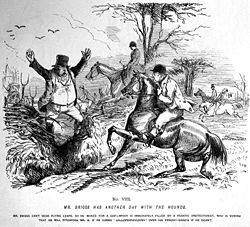 Punch magazine's "Mr. Briggs" cartoons illustrated issues over fox hunting during the 1850s.
Punch magazine's "Mr. Briggs" cartoons illustrated issues over fox hunting during the 1850s.
In the UK, supporters of fox hunting regard it as a distinctive part of British culture generally, the basis of traditional crafts and a key part of social life in rural areas, an activity and spectacle enjoyed not only by the riders but also by others such as the unmounted pack which may follow along on foot, bicycle or 4x4.[5] They see the social aspects of hunting as reflecting the demographics of the area; the Home Counties packs, for example, are very different from those in North Wales and Cumbria, where the hunts are very much the activity of farmers and the working class. The Banwen Miners Hunt has been used as an example, founded in a small Welsh mining village, although its membership now is by no means limited to miners, with a cosmopolitan make up.[127]
Oscar Wilde, in his 1893 play A Woman of No Importance, once famously referred to "the English country gentleman galloping after a fox" as "the unspeakable in full pursuit of the uneatable."[128] Even before the time of Wilde, much of the criticism of fox hunting has been couched in terms of social class. They argue that while more "working class" blood sports such as cock fighting and badger baiting were long ago outlawed,[129][130] fox hunting persists, although this argument can be countered with the fact that hare coursing, a more 'working class' sport was outlawed simultaneously to fox hunting with hounds in the UK. Philosopher Roger Scruton believes that the analogy with cock fighting and badger baiting is unfair because these sports were more cruel and did not involve any element of pest control.[116]
John Leech had a series of "Mr. Briggs" cartoons in Punch during the 1850s, which illustrated class issues.[131] More recently the British anarchist group Class War has argued explicitly for disruption of fox hunts on class warfare grounds and even published a book The Rich at Play examining the subject.[132] Other groups with similar aims, such as 'Revolutions per minute' have also published papers which disparage fox hunting on the basis of the social class of its participants.[133]
Polls in the UK have shown that the UK public equally divided as to whether or not hunt objectors hold their views based primarily on class grounds.[134] Some people point to evidence of class bias in the voting patterns in the British House of Commons during voting on the hunting bill 2000-2001, with traditionally working class Labour forcing legislation through against the votes of normally middle and upper class Conservative members.[135]
In popular culture
Fox hunting has inspired artists in several fields to create works which involve the sport. The most famous usage is in the Daniel P Mannix 1967 novel titled The Fox and the Hound which follows a story of a fox called Tod and a hound called Copper. This story was subsequently used by Walt Disney Pictures to create the animated feature length film The Fox and the Hound in 1981,[136] although the film differs from the novel in that Tod and Copper befriend each other and survive as friends.[137] Other children's books which involve fox characters becoming involved with a hunt or being hunted include The Animals of Farthing Wood,[138] and Roald Dahl's Fantastic Mr Fox. Poet Laureate John Masefield wrote "Reynard the Fox", a poem about a fox hunt in rural England in which the title character escapes. In a Conan Doyle story, the French officer Brigadier Gerard joins an English fox hunt, but commits the unpardonable sin of slaying the fox with his sabre. Author Rita Mae Brown has authored a series of fox-hunting mysteries starring "Sister" Jane Arnold, starting with Outfoxed in 2000.[139] In real life, Brown is the master of the Oak Ridge Fox Hunt Club.[140]
There have also been several musical artists who have used fox hunting, with both Ray Noble and George Formby recording Tan Tan Tivvy Tally Ho!, a comic song about fox hunting, in 1932 and 1938 respectively.[141] More recently Dizzee Rascal used the concept of a fox-hunt for his video of Sirens, showing a stylised urban hunt.[142] The foxhunt is a prominent feature of the 1963 movie The List of Adrian Messenger. Sting has also written and recorded a song that references a pair of foxes during a hunt, called "The End of the Game."[143]
See also
- Animal welfare
- Anti-hunting
- Beagling
- Beagling on horseback
- Deer hunting
- Fox tossing
- Hare coursing
- Hunting and shooting in the United Kingdom
- List of fox hunts in the United Kingdom
- Wolf hunting
References
- ^ a b c d e f g h i j k "The Final Report of the Committee of Inquiry into Hunting with Dogs in England and Wales". Her Majesty's Stationery Office. 2000-06-09. Archived from the original on 2009-04-10. http://web.archive.org/web/20090410213249/http://www.defra.gov.uk/rural/hunting/inquiry/mainsections/huntingreport.htm. Retrieved 2008-02-10.
- ^ a b "Fox hunting worldwide". BBC News. 1999-09-16. http://news.bbc.co.uk/1/hi/uk/428122.stm. Retrieved 2007-10-05.
- ^ a b c d Aslam, D (2005-02-18). "Ten things you didn't know about hunting with hounds". London: The Guardian. http://www.guardian.co.uk/uk/2005/feb/18/hunting.immigrationpolicy2. Retrieved 2007-11-03.
- ^ a b c "Hunt ban forced through Commons". BBC News. 2004-11-19. http://news.bbc.co.uk/2/hi/uk_news/politics/4020453.stm. Retrieved 2008-02-22.
- ^ "Creation and conservation of habitat by foxhunting". Masters of Fox Hounds Association. http://www.mfha.org.uk/index.php?option=com_content&task=view&id=64&Itemid=56. Retrieved 2007-10-13.
- ^ "The need for wildlife management". Masters of Fox Hounds Association. http://www.mfha.org.uk/index.php?option=com_content&task=view&id=65&Itemid=54. Retrieved 2007-10-07.
- ^ "The morality of hunting with dogs" (PDF). Campaign to Protect Hunted Animals. http://www.league.org.uk/uploads/documents/doc_271.pdf. Retrieved 2007-10-13.
- ^ Aslam, Dilpazier (2005-02-18). "Ten things you didn't know about hunting with hounds". London: The Guardian. http://www.guardian.co.uk/uk/2005/feb/18/hunting.immigrationpolicy2. Retrieved 2007-11-03.
- ^ "Forest and Chases in England and Wales c. 1000 to c.1850". St John's College, Oxford. http://info.sjc.ox.ac.uk/forests/glossary.htm. Retrieved 2008-02-16.
- ^ Ridley, Jane (1990-10). Fox Hunting. HarperCollins. ISBN 978-0002179492.
- ^ a b c d Birley, D. (1993). Sport and the Making of Britain. Manchester University Press. pp. 130–132. ISBN 9780719037597. http://books.google.com/?id=qVQiOYkBvV8C&pg=PA130&lpg=PA130&dq=%22Inclosure+Acts+%22+deer+hunting. Retrieved 2008-02-14.
- ^ a b c Carr, Raymond (1976). English Fox Hunting: A History. Weidenfeld & Nicolson. ISBN 0 297 77074 8.
- ^ "Game Act 1831". United Kingdom Ministry of Justice. http://www.statutelaw.gov.uk/legResults.aspx?LegType=All+Legislation&title=Game+Act&Year=1831&searchEnacted=0&extentMatchOnly=0&confersPower=0&blanketAmendment=0&TYPE=QS&NavFrom=0&activeTextDocId=1032098&PageNumber=1&SortAlpha=0. Retrieved 2007-11-03.
- ^ a b Harrison, David; Paterson, Tony (2002-09-22). "Thanks to Hitler, hunting with hounds is still verboten". London: The Telegraph. http://www.telegraph.co.uk/news/uknews/1407954/Thanks-to-Hitler-hunting-with-hounds-is-still-verboten.html. Retrieved 2010-05-19.
- ^ a b c d e f g h i "History of American Foxhunting". Masters of Foxhounds of North America. 2008. Archived from the original on June 3, 2008. http://web.archive.org/web/20080603045754/http%3A//www.mfha.com/abfo.htm#his. Retrieved 2008-02-10.
- ^ Presnall, C.C. (1958). "The Present Status of Exotic Mammals in the United States". The Journal of Wildlife Management, 22(1). pp. 45–50. http://links.jstor.org/sici?sici=0022-541X(195801)22%3A1%3C45%3ATPSOEM%3E2.0.CO%3B2-Z. Retrieved 2008-02-21.
- ^ Churcher, C.S. (1959). "The Specific Status of the New World Red Fox". Journal of Mammalogy, 40(4). pp. 513–520. http://links.jstor.org/sici?sici=0022-2372(195911)40%3A4%3C513%3ATSSOTN%3E2.0.CO%3B2-V. Retrieved 2008-02-21.
- ^ "Profile - George Washington". Explore DC. 2001. http://www.exploredc.org/index.php?id=69. Retrieved 2007-11-14.
- ^ "A short history of foxhunting in Virginia". Freedom Fields Farm. http://www.freedomfields.net/foxhunting_in_virginia.html. Retrieved 2007-11-14.
- ^ a b Eastham, Jaime. "Australia's Noah's Ark springs a leak". Australian Conservation Foundation. http://www.acfonline.org.au/news.asp?news_id=345&c=10032. Retrieved 2008-02-10.
- ^ a b "It's the thrill not the kill, they say". Melbourne: Fairfax Digital. 2005-03-20. http://www.theage.com.au/news/National/Its-the-thrill-not-the-kill-they-say/2005/03/19/1111086058304.html?from=moreStories. Retrieved 2007-11-02.
- ^ "Bounty fails to win ground war against foxes". Melbourne: Fairfax Digital. 2003-05-05. http://www.theage.com.au/articles/2003/05/04/1051987602914.html. Retrieved 2007-11-02.
- ^ "Hunting Act 2004". HMSO. http://www.opsi.gov.uk/acts/acts2004/ukpga_20040037_en_1.htm. Retrieved 2008-02-12.
- ^ Ahmed, Kamal; Barnett, Antony (2001-03-25). "Historic deal offers reprieve for hunting". London: The Observer. http://www.guardian.co.uk/politics/2001/mar/25/hunting.immigrationpolicy. Retrieved 2008-02-22.
- ^ Hencke, D. (2000-01-04). "Row over hunting inquiry 'bias'". London: Guardian. http://www.guardian.co.uk/uk/2000/jan/24/hunting.ruralaffairs. Retrieved 2008-02-25.
- ^ "Protesters storm UK parliament". CNN. 2004-09-16. Archived from the original on November 18, 2004. http://web.archive.org/web/20041118064259/http%3A//edition.cnn.com/2004/WORLD/europe/09/15/fox.protest/. Retrieved 2008-10-27.
- ^ "Protection of Wild Mammals (Scotland) Act". HMSO. 2002. http://www.opsi.gov.uk/legislation/scotland/acts2002/asp_20020006_en_1. Retrieved 2008-02-12.
- ^ Hookham, Mark (2007-03-15). "Hain lambasted over website backing hunting". Belfast Telegraph. Archived from the original on April 4, 2007. http://web.archive.org/web/20070404204148/http%3A//www.belfasttelegraph.co.uk/news/local-national/article2360161.ece. Retrieved 2008-02-22.
- ^ "Northern Ireland bans hare coursing, and fox hunting could be next". 2010-06-24. http://www.belfasttelegraph.co.uk/news/local-national/northern-ireland-bans-hare-coursing-and-fox-hunting-could-be-next-14852888.html. Retrieved 2011-03-29.
- ^ "Hunting season barely underway and 40% of hunts could be breaking the law" (Press release). League Against Cruel Sports. 2005-11-04. http://www.league.org.uk/news_details.asp?NewsID=795. Retrieved 2007-10-13.
- ^ "'More foxes dead' since hunt ban". BBC News. 2006-02-17. http://news.bbc.co.uk/1/hi/uk/4724028.stm. Retrieved 2007-10-13.
- ^ "Hunts hail Boxing Day turn-out". BBC News. 2006-12-26. http://news.bbc.co.uk/1/hi/uk/6209365.stm. Retrieved 2007-10-13.
- ^ a b c Smart, Bruce (2004). "9" (PDF). A community of the horse. http://www.acommunityofthehorse.com/images/pdfs/ChapIX.pdf. Retrieved 2008-04-09.
- ^ "Geographical listing of hunts". Masters of Foxhounds Association of North America. 2007. Archived from the original on June 3, 2008. http://web.archive.org/web/20080603130741/http%3A//www.mfha.com/memb.htm. Retrieved 2008-02-12.
- ^ "Arapahoe Hunt Club History". Arapahoe Hunt Club. 2007. http://www.arapahoehunt.com/history.asp. Retrieved 2008-02-12.
- ^ "Recognized Hunts". Chronicle of the Horse. http://www.chronofhorse.com/index.php?cat=123009040576283. Retrieved 2008-02-12.
- ^ home.jpg
- ^ "Diet". Derbyshire Fox Rescue. Derbyshire Fox Rescue. 2006. http://www.derbyfoxes.org/diet.htm. Retrieved 2007-09-09.
- ^ "Peatland Wildlife - The Fox". Northern Ireland Environment and Heritage Service. 2004. http://www.peatlandsni.gov.uk/wildlife/mammals/redfox.htm. Retrieved 2007-10-13.
- ^ a b c d Fox, David. "Vulpes vulpes (red fox)". University of Michigan - Animal Diversity Web. http://animaldiversity.ummz.umich.edu/site/accounts/information/Vulpes_vulpes.html. Retrieved 2007-10-13.
- ^ "Todd". Behind the name. 2007. http://www.behindthename.com/name/todd. Retrieved 2007-10-14.
- ^ "Reynard the Fox". Encyclopaedia Britannica 1911. http://www.1911encyclopedia.org/Reynard_The_Fox. Retrieved 2007-10-14.
- ^ "Three centuries of hunting foxes". BBC News. 1999-09-16. http://news.bbc.co.uk/1/hi/uk/422753.stm. Retrieved 2007-10-13.
- ^ Sketches in Natural History: History of the Mammalia. By Charles Knight Published by C. Cox, 1849
- ^ Houben, JM (2004). "Status and management of coyote depredations in the Eastern United States". US Department of Agriculture. http://digitalcommons.unl.edu/cgi/viewcontent.cgi?article=1006&context=icwdmsheepgoat. Retrieved 2007-10-13.
- ^ Tokar, Eric. "Canis latrans (coyote)". University of Michigan - Animal Diversity Web. http://animaldiversity.ummz.umich.edu/site/accounts/information/Canis_latrans.html. Retrieved 2007-10-13.
- ^ Coppinger, Ray (2001). Dogs: a Startling New Understanding of Canine Origin, Behavior and Evolution. New York: Scribner. p. 352. ISBN 0684855305.
- ^ Jansa, Sharon. "Urocyon cirereoargentus (gray fox)". University of Michigan - Animal Diversity Web. http://animaldiversity.ummz.umich.edu/site/accounts/information/Urocyon_cinereoargenteus.html. Retrieved 2007-10-13.
- ^ The Viviparious Quadrupeds of North America By John James Audubon, John Bachman Published by Audubon, 1846
- ^ "Hurworth hound bound for India". Horse and Hound. 2004-05-24. http://www.horseandhound.co.uk/competitionnews/392/49235.html. Retrieved 2007-10-13.
- ^ "Unusual features of RAF Habbaniya (Iraq)". RAF Habbaniya Association. http://www.habbaniya.org/Features.html. Retrieved 2007-10-13.
- ^ An Encyclopaedia of Rural Sports: Or a Complete Account, Historical, Practical, and Descriptive, of Hunting, Shooting, Fishing, Racing, and Other Field Sports and Athletic Amusements of the Present Day, Delabere Pritchett Blaine by Delabere Pritchett Blaine, published by Longman, Orme, Brown, Green and Longmans, 1840
- ^ A monograph of the canidae by St. George Mivart, F.R.S, published by Alere Flammam. 1890
- ^ The Sports Library Riding, Driving and Kindred Sports by T. F. Dale, published by BiblioBazaar, LLC, 2009, ISBN 1-110-58955-7
- ^ "English Foxhound History". American Kennel Club. http://www.akc.org/breeds/english_foxhound/history.cfm. Retrieved 2007-10-15.
- ^ "English Foxhound Breed Standard". American Kennel Club. http://www.akc.org/breeds/english_foxhound/. Retrieved 2007-10-15.
- ^ "American Foxhound Breed Standard". American Kennel Club. http://www.akc.org/breeds/american_foxhound/. Retrieved 2007-10-15.
- ^ "Greyhound History". American Kennel Club. http://www.akc.org/breeds/greyhound/history.cfm. Retrieved 2007-10-15.
- ^ "End of the road for illegal hare coursing". BBC Inside Out. 2005-01-24. http://www.bbc.co.uk/insideout/east/series7/hare_coursing.shtml. Retrieved 2007-10-15.
- ^ "Hunt Etiquette". Waitemata Hunt. October 2008. http://members.tripod.com/horse_hunting/sitebuildercontent/sitebuilderfiles/hunt_etiquette.pdf. Retrieved 2010-12-29.
- ^ a b "Information and Guidelines for Foxhunters in the Field". Independence Foxhounds. 2007. Archived from the original on 2008-03-08. http://web.archive.org/web/20080308004907/http://www.independencefoxhounds.com/protocol.html. Retrieved 2008-01-18.
- ^ "Hunting Hounds and Polo Ponies". JoCo History. 1998. http://www.jocohistory.net/culture/11no3hunting.asp. Retrieved 2008-01-18.
- ^ Moss, Stephen (2006-11-07). "The banned rode on". London: The Guardian. http://www.guardian.co.uk/uk/2006/nov/07/hunting.ethicalliving. Retrieved 2007-10-05.
- ^ "Four men deny hunting with dogs". BBC News. 2007-07-02. http://news.bbc.co.uk/1/hi/england/hampshire/6262524.stm. Retrieved 2007-10-05.
- ^ "Steeplechase". Encyclopaedia Britannica Online. 2008. http://www.britannica.com/eb/article-9069520/steeplechase. Retrieved 2008-02-10.
- ^ "A History of Point to Point". Irish Point to Point. 2003. http://www.p2p.ie/content.php?key=History. Retrieved 2011-11-06.
- ^ a b c "Customs of Hunting". Icons - A portrait of Britain. 2006. http://www.icons.org.uk/theicons/collection/fox-hunting-and-the-ban/features/customs-of-hunting-finished. Retrieved 2007-11-13.
- ^ Thomas, L.H. & Allen, W.R. (2000). "A veterinary opinion on hunting with hounds, Submission to the Burns Inquiry". Defra. http://www.defra.gov.uk/rural/hunting/inquiry/evidence/vetgroup.htm#autumn. Retrieved 2007-11-20.[dead link]
- ^ Fanshawe (2003). "Future of hound breeds under threat from hunting bill". Masters of Fox Hounds Association. http://www.mfha.org.uk/index.php?option=com_content&task=view&id=18&Itemid=9. Retrieved 2008-02-11.
- ^ "American Foxhunting - Attire". Masters of Foxhounds Association of North America. Archived from the original on June 3, 2008. http://web.archive.org/web/20080603045754/http%3A//www.mfha.com/abfo.htm#att. Retrieved 2008-10-18.
- ^ a b "What is drag hunting?". North East Cheshire Drag Hunt. 2008. http://www.necdh.co.uk/WhatIsDragHunting.htm. Retrieved 2008-02-11.
- ^ a b "The Masters of Draghounds and Bloodhounds Association, Submission to Burns Inquiry". Defra. 2000. Archived from the original on 2008-08-11. http://web.archive.org/web/20080811140700/http://www.defra.gov.uk/rural/hunting/inquiry/evidence/mdba.htm. Retrieved 2008-02-21.
- ^ "Hunting humans, not foxes". BBC News. 1999-09-20. http://news.bbc.co.uk/1/hi/uk/417435.stm. Retrieved 2008-02-17.
- ^ "Hound Trailing". Hound Trailing Association. http://www.houndtrailing.org.uk/. Retrieved 2008-03-11.
- ^ Bloomfield, R. (2005-01-07). All about drag hunting. Horse & Hound.
- ^ a b "Drag Hunting". New Forest Drag Hunt. http://www.nfdh.org.uk/draghunting.html. Retrieved 2008-02-11.
- ^ "Fox Ecology". Tasmanian Department of Primary Industries and Water. 2007-12. http://www.dpiw.tas.gov.au/inter.nsf/WebPages/LBUN-5K52J2?open. Retrieved 2008-02-10.
- ^ "Pest series:The fox". Queensland Government Natural Resources and Water. January 2007. http://www.dpi.qld.gov.au/documents/Biosecurity_EnvironmentalPests/IPA-Fox-PA13.pdf. Retrieved 2008-02-17.
- ^ "Lamping code of practice". The British Association for Shooting and Conservation. September 2010. http://www.basc.org.uk/en/codes-of-practice/lamping.cfm. Retrieved 2011-11-06.
- ^ a b c d "Organization in the field". Miami Valley Hunt. http://mvhunt.net/foxhunting.htm. Retrieved 2008-08-13.
- ^ "Code of conduct". Irish Masters of Foxhounds Association. http://fresco.ie/imfha/conduct2.htm. Retrieved 2008-02-11.
- ^ "About Parliament - Whips". UK Parliament. http://www.parliament.uk/about/how/principal/whips.cfm. Retrieved 2008-10-17.
- ^ "Hunt terriermen". Campaign for the Abolition of Terrier Work. Archived from the original on 2008-05-12. http://web.archive.org/web/20080512003440/http://www.diggingout.org/hunt_terriermen.html. Retrieved 2008-02-11.
- ^ Reeds, Jim (2003-12-07). "The Legend of Tailor Pink". horse-country.com. http://www.horse-country.com/jriders/pink.html. Retrieved 2007-10-13.
- ^ "Hunting Fashion". Icons - A portrait of Britain. 2006-07. http://www.icons.org.uk/theicons/collection/fox-hunting-and-the-ban/features/hunting-fashion. Retrieved 2007-11-14.
- ^ a b c "Dress Code". Beech Grove Hunt. Archived from the original on November 4, 2007. http://web.archive.org/web/20071104000503/http%3A//www.beechgrovehunt.com/etiquette.shtml. Retrieved 2007-11-14.
- ^ "Dress Code". RMA Sandhurst Draghunt. 2008. Archived from the original on March 14, 2008. http://web.archive.org/web/20080314000035/http%3A//www.sandhurstdraghunt.co.uk/dress.html. Retrieved 2007-12-22.
- ^ Committee of Inquiry into Hunting with Dogs (1999). "Background to the Inquiry". Archived from the original on 2009-04-07. http://web.archive.org/web/20090407134938/http://www.defra.gov.uk/rural/hunting/inquiry/mainsections/committeedetails/aboutus.htm. Retrieved 2008-02-12.
- ^ "Final Report of the Committee of Inquiry into Hunting with Dogs in England and Wales, para 4.12". Defra. 2000-06-09. Archived from the original on 2009-04-10. http://web.archive.org/web/20090410213249/http://www.defra.gov.uk/rural/hunting/inquiry/mainsections/huntingreport.htm. Retrieved 2008-02-09.
- ^ "Hunt Crimewatch". League Against Cruel Sports. http://www.league.org.uk/content.asp?CategoryID=1704. Retrieved 2008-02-12.
- ^ "RSPCA wins right to block hunt lobby". London: The Telegraph. 2001-06-19. http://www.telegraph.co.uk/news/uknews/1319660/RSPCA-wins-right-to-block-hunt-lobby.html. Retrieved 2008-10-27.
- ^ "HSA hunt tactics book". Hunt Saboteurs Association. http://hsa.enviroweb.org/tactics/tactbook/tactics.html. Retrieved 2008-02-12.
- ^ "Hunter Harassment Laws". American Hunt Saboteurs Association. http://www.huntsab.org/hunter_harassment_laws.htm. Retrieved 2008-02-12.
- ^ a b c d e Countryside Alliance (2000). "Submission to the Burns Inquiry". Defra. http://www.defra.gov.uk/rural/hunting/inquiry/evidence/alliance.htm. Retrieved 2007-11-14.[dead link]
- ^ Ryder, R. (2000). "Submission to the Burns Inquiry". Defra. http://www.defra.gov.uk/rural/hunting/inquiry/evidence2/drryder.htm. Retrieved 2008-02-11.[dead link]
- ^ Kruuk, H (1972). "Surplus killing by carnivores". Journal of Zoology, London 166: 435–50.
- ^ Baldwin, Marc (2007-04-29). "Red Fox Vulpes vulpes:Food & Feeding". Wildlife Online. http://www.wildlifeonline.me.uk/red_fox.html#feeding. Retrieved 2008-02-22.
- ^ "Red fox (Vulpes vulpes) General description". National Fox Welfare Society. http://www.nfws.org.uk/fox_info.html. Retrieved 2008-04-13.
- ^ "New research explodes myth that hunting with gun-packs controlled foxes in Wales". International Fund for Animal Welfare. 2006. Archived from the original on June 20, 2008. http://web.archive.org/web/20080620022132/http%3A//www.ifaw.org/ifaw/general/default.aspx%3Foid%3D158534. Retrieved 2008-02-11.
- ^ Deadline 2000 (2000). "Submission to Burns Inquiry". Defra. http://www.defra.gov.uk/rural/hunting/inquiry/evidence2/deadline20002.htm#research. Retrieved 2008-02-12.[dead link]
- ^ a b League Against Cruel Sports (2000). "Submission to Burns Inquiry". Defra. http://www.defra.gov.uk/rural/hunting/inquiry/evidence/league.htm. Retrieved 2008-02-11.[dead link]
- ^ "European Red Fox Fact Sheet" (PDF). Environment Department, Australian Government. 2004. http://www.environment.gov.au/biodiversity/invasive/publications/european-red-fox.html. Retrieved 2010-04-19.
- ^ "THE HUMANENESS OF RODENT PEST CONTROL" (PDF). Animal Welfare 2003, 12: 000-000. 2003. http://origin.www.helpinganimals.com/pdfs/TheHumanenessOfRodentControlAnimal%20Welfare-2003.pdf. Retrieved 2010-06-08.
- ^ Simon Hart (2007-12-26). "Hounding out a law that's failed in every way". Yorkshire Post. http://www.yorkshirepost.co.uk/opinion/Simon-Hart-Hounding-out-a.3619917.jp. Retrieved 2008-02-11.
- ^ a b "Is fox hunting cruel?". BBC News. 1999-09-16. http://news.bbc.co.uk/1/hi/uk/418681.stm. Retrieved 2007-11-03.
- ^ "The universal declaration of animal rights". Uncaged. 2006. http://www.uncaged.co.uk/declarat.htm. Retrieved 2007-11-03.
- ^ "General FAQs". People for the Ethical Treatment of Animals (PETA). http://www.peta.org/about/faq.asp. Retrieved 2007-11-03.
- ^ "MFHA Code of Hunting Practices". Masters of Foxhounds Association of North America. 2000. Archived from the original on March 15, 2008. http://web.archive.org/web/20080315131747/http%3A//www.mfha.com/code.htm. Retrieved 2008-02-12.
- ^ Baker, P., Harris, S. & White, P.. "After the hunt, the future of foxes in Britain" (PDF). International Fund for Animal Welfare. Archived from the original on November 27, 2007. http://web.archive.org/web/20071127073352/http%3A//www.ifaw.org/ifaw/dimages/custom/After%2520the%2520Hunt%2520%28Web%2520final%2520Feb%29.pdf. Retrieved 2007-11-25.
- ^ Four Burrows Hunt (2000). "Submission to Burns Inquiry". Defra. http://www.defra.gov.uk/rural/hunting/inquiry/evidence/hunts/fourburrow.htm. Retrieved 2008-02-12.[dead link]
- ^ Linzey, A. (2006). "Fox Hunting" (PDF). Christian Socialist Movement. http://www.league.org.uk/uploads/documents/doc_336.pdf. Retrieved 2008-02-11.
- ^ "R. (oao The Countryside Alliance; oao Derwin and others) v. Her Majesty's Attorney General and Secretary of State of Environment, Food and Rural Affairs". EWCA. 2006-06-23. http://www.bailii.org/ew/cases/EWCA/Civ/2006/817.html. Retrieved 2008-02-11.
- ^ Fanshawe, B. (2000-05-17). "Details of number of hounds involved in hunting, Campaign for Hunting submission to Burns Inquiry". Defra. http://www.defra.gov.uk/rural/hunting/inquiry/evidence2/hounds.htm. Retrieved 2008-02-18.[dead link]
- ^ "The Hare Hunting Associations, submission to Burns Inquiry". Defra. 2000. http://www.defra.gov.uk/rural/hunting/inquiry/evidence2/amhbmbhanccalc.htm. Retrieved 2008-04-10.[dead link]
- ^ a b Scruton, Roger (2000). "Fox Hunting: The Modern Case. Written submission to the Burns Inquiry". Defra. http://www.defra.gov.uk/rural/hunting/inquiry/evidence/scruton.htm. Retrieved 2007-11-18.[dead link]
- ^ Medema, S.G. & Samuels, W.J. (2003). The history of economic thought. Routledge. ISBN 9780415205511. http://books.google.com/?id=4PslOtUYstsC&pg=PA360&lpg=PA360&dq=%22the+reasons+for+legal+intervention+in+favour+of+children%22. Retrieved 2007-11-18.
- ^ "House of Lords judgement on Hunting Act ECHR challenge". House of Lords. 2007-11-28. http://www.publications.parliament.uk/pa/ld200708/ldjudgmt/jd071128/countr-1.htm. Retrieved 2007-11-29.
- ^ "HECtHR judgment in case Friend and Countryside Alliance and Others v. UK". ECtHR. 2009-11-24. http://cmiskp.echr.coe.int/tkp197/view.asp?action=html&documentId=859952&portal=hbkm&source=externalbydocnumber&table=F69A27FD8FB86142BF01C1166DEA398649. Retrieved 2010-01-11.
- ^ "Legal advice for activists". Free Beagles. http://freebeagles.org/articles/Legal_Booklet_4/lb4-21.html.
- ^ a b c d Stokes, Elizabeth (1996). Hunting and Hunt Saboteurs: A Censure Study. http://www.uel.ac.uk/law/staff/esarchive.htm. Retrieved 2006-12-17.
- ^ "Legal advice on Public Order and trespass". Hunt Saboteurs Association. http://hsa.enviroweb.org/tactics/tactbook/legal.html. Retrieved 2007-11-03.
- ^ "Trespass and Nuisance on Land: Legal Guidance". Crown Prosecution Service. http://www.cps.gov.uk/legal/s_to_u/trespass_and_nuisance_on_land/#Aggravated_Trespass_Charging.
- ^ Countryside Alliance and the Council of Hunting Associations (2006). "Hunting without Harassment" (PDF). Countryside Alliance. http://www.countryside-alliance.org.uk/images/stories/pdf/hunting_hb_2006-7.pdf. Retrieved 2007-11-03.[dead link]
- ^ Salt, H. (1915). "Drag Hunting Verses Stag Hunting". Killing for Sport. Archived from the original on March 5, 2008. http://web.archive.org/web/20080305211816/http%3A//www.henrysalt.co.uk/bs_drag_hunts.htm. Retrieved 2008-02-11.
- ^ Kallenbach, M (2002-03-19). "Peer warns of a war with countryside". London: Telegraph. http://www.telegraph.co.uk/news/main.jhtml?xml=/news/2002/03/20/nhunt120.xml. Retrieved 2008-04-10.
- ^ "Banwen Miners Hunt History". The Banwen Miners Hunt. http://www.banwenminershunt.co.uk/index_files/History.htm. Retrieved 2007-12-02.[dead link]
- ^ "Oscar Wilde". Bibliomania. http://www.bibliomania.com/0/2/57/frameset.html. Retrieved 2007-11-16.
- ^ "Banned Blood Sports". Icons- a portrait of England. 2006. http://www.icons.org.uk/theicons/collection/fox-hunting-and-the-ban/features/banned-blood-sports. Retrieved 2007-11-03.
- ^ Jackson, Steve (2006). "Badger Baiting". Badger Pages. http://www.badgers.org.uk/badgerpages/eurasian-badger-11.html. Retrieved 2007-11-05.
- ^ "John Leech Hunting archive". Andrew Cates. http://john-leech-archive.org.uk/keyword/hunting.htm. Retrieved 2008-02-11.
- ^ "Class War Merchandise". London Class War. http://lemming.mahost.org/classwar/merchandise.htm. Retrieved 2007-11-03.[dead link]
- ^ "The Rich at Play". Red Star Research/Revolutions per minute. 2002. Archived from the original on 2007-09-15. http://web.archive.org/web/20070915170129/http://www.red-star-research.org.uk/rap/rapframe.html. Retrieved 2007-11-14.
- ^ Clover, Charles (1999-07-27). "New poll shows public not prepared to outlaw hunting". London: The Telegraph. Archived from the original on November 3, 2007. http://web.archive.org/web/20071103121423/http%3A//www.telegraph.co.uk/htmlContent.jhtml%3Fhtml%3D/archive/1999/07/27/nhunt127.html. Retrieved 2008-02-11.
- ^ Orendi, Dagmar (2004). "The debate about fox hunting - A social and political analysis". Humbolt Univeritat zu Berlin (Master Thesis). http://www2.hu-berlin.de/gbz/downloads/pdf/DagmarOrendi_MasterThesis.pdf. Retrieved 2007-10-13.
- ^ "The Fox and the Hound (1981)". Internet Movie Database. http://www.imdb.com/title/tt0082406/. Retrieved 2007-11-16.
- ^ "Disney's The Fox and the Hound: The Coming of the Next Generation". Animation World Magazine 3 (8). November 1998. http://www.awn.com/mag/issue3.8/3.8pages/3.8sitofox.html. Retrieved 2008-02-17.
- ^ Dann, Colin (November 1979). The Animals of Farthing Wood. Hutchinson. ISBN 0434934305.
- ^ "The 'Sister' Jane Foxhunting mysteries". RitaMaeBrown.com. http://www.ritamaebrown.com/content/books_ja.asp. Retrieved 2009-01-28.
- ^ "Oak Ridge Fox Hunt Club". http://www.oakridgefoxhuntclub.com. Retrieved 2009-01-28.
- ^ "George Formby Discography". George Formby: Pride of Manchester. http://www.prideofmanchester.com/music/GeorgeFormby-discography3.htm. Retrieved 2008-02-11.
- ^ "Video:Dizzee Rascal: Sirens". Pitchfork. Archived from the original on December 17, 2007. http://web.archive.org/web/20071217102453/http%3A//www.pitchforkmedia.com/article/download/42113-dizzee-rascal-sirens-. Retrieved 2007-11-16.
- ^ "The End of the Game (1999)". Sting Discography. http://www.sting.com/discog/?v=so&a=1&id=127.[dead link]
External links
- General
- News media
- Hunting and pro-hunting organisations
- Masters of Foxhounds Association (UK)
- Masters of Foxhounds Association of America (USA and Canada)
- Countryside Alliance — Campaign for Hunting[dead link] (UK)
- The Parliamentary Middle Way Group (UK)
- Veterinary Association for Wildlife Management
- Anti-hunting organisations
- Hunt Saboteurs Association (UK)
- League Against Cruel Sports — Hunting with Dogs (UK)
- RSPCA — Ban Hunting (UK)
- Government reports
- The Burns Inquiry — The Committee of Inquiry into Hunting with Dogs in England and Wales[dead link] (UK Government Inquiry), 2000.
Categories:- Animal rights
- Animal welfare
- British society
- Fox hunting
Wikimedia Foundation. 2010.

